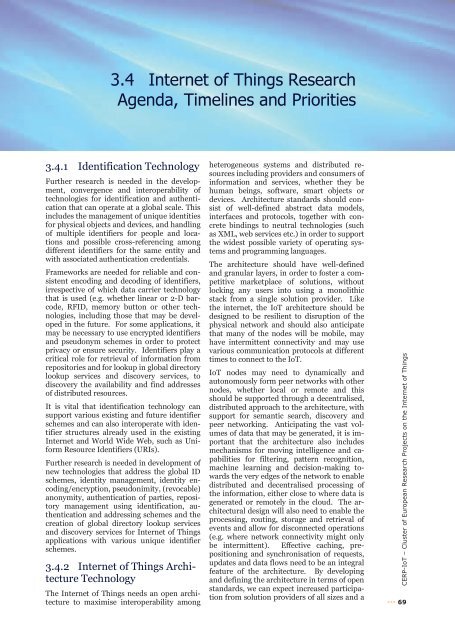Vision and Challenges for Realising the Internet of Things
Vision and Challenges for Realising the Internet of Things
Vision and Challenges for Realising the Internet of Things
You also want an ePaper? Increase the reach of your titles
YUMPU automatically turns print PDFs into web optimized ePapers that Google loves.
3.4 <strong>Internet</strong> <strong>of</strong> <strong>Things</strong> Research<br />
Agenda, Timelines <strong>and</strong> Priorities<br />
3.4.1 Identification Technology<br />
Fur<strong>the</strong>r research is needed in <strong>the</strong> development,<br />
convergence <strong>and</strong> interoperability <strong>of</strong><br />
technologies <strong>for</strong> identification <strong>and</strong> au<strong>the</strong>ntication<br />
that can operate at a global scale. This<br />
includes <strong>the</strong> management <strong>of</strong> unique identities<br />
<strong>for</strong> physical objects <strong>and</strong> devices, <strong>and</strong> h<strong>and</strong>ling<br />
<strong>of</strong> multiple identifiers <strong>for</strong> people <strong>and</strong> locations<br />
<strong>and</strong> possible cross-referencing among<br />
different identifiers <strong>for</strong> <strong>the</strong> same entity <strong>and</strong><br />
with associated au<strong>the</strong>ntication credentials.<br />
Frameworks are needed <strong>for</strong> reliable <strong>and</strong> consistent<br />
encoding <strong>and</strong> decoding <strong>of</strong> identifiers,<br />
irrespective <strong>of</strong> which data carrier technology<br />
that is used (e.g. whe<strong>the</strong>r linear or 2-D barcode,<br />
RFID, memory button or o<strong>the</strong>r technologies,<br />
including those that may be developed<br />
in <strong>the</strong> future. For some applications, it<br />
may be necessary to use encrypted identifiers<br />
<strong>and</strong> pseudonym schemes in order to protect<br />
privacy or ensure security. Identifiers play a<br />
critical role <strong>for</strong> retrieval <strong>of</strong> in<strong>for</strong>mation from<br />
repositories <strong>and</strong> <strong>for</strong> lookup in global directory<br />
lookup services <strong>and</strong> discovery services, to<br />
discovery <strong>the</strong> availability <strong>and</strong> find addresses<br />
<strong>of</strong> distributed resources.<br />
It is vital that identification technology can<br />
support various existing <strong>and</strong> future identifier<br />
schemes <strong>and</strong> can also interoperate with identifier<br />
structures already used in <strong>the</strong> existing<br />
<strong>Internet</strong> <strong>and</strong> World Wide Web, such as Uni<strong>for</strong>m<br />
Resource Identifiers (URIs).<br />
Fur<strong>the</strong>r research is needed in development <strong>of</strong><br />
new technologies that address <strong>the</strong> global ID<br />
schemes, identity management, identity encoding/encryption,<br />
pseudonimity, (revocable)<br />
anonymity, au<strong>the</strong>ntication <strong>of</strong> parties, repository<br />
management using identification, au<strong>the</strong>ntication<br />
<strong>and</strong> addressing schemes <strong>and</strong> <strong>the</strong><br />
creation <strong>of</strong> global directory lookup services<br />
<strong>and</strong> discovery services <strong>for</strong> <strong>Internet</strong> <strong>of</strong> <strong>Things</strong><br />
applications with various unique identifier<br />
schemes.<br />
3.4.2 <strong>Internet</strong> <strong>of</strong> <strong>Things</strong> Architecture<br />
Technology<br />
The <strong>Internet</strong> <strong>of</strong> <strong>Things</strong> needs an open architecture<br />
to maximise interoperability among<br />
heterogeneous systems <strong>and</strong> distributed resources<br />
including providers <strong>and</strong> consumers <strong>of</strong><br />
in<strong>for</strong>mation <strong>and</strong> services, whe<strong>the</strong>r <strong>the</strong>y be<br />
human beings, s<strong>of</strong>tware, smart objects or<br />
devices. Architecture st<strong>and</strong>ards should consist<br />
<strong>of</strong> well-defined abstract data models,<br />
interfaces <strong>and</strong> protocols, toge<strong>the</strong>r with concrete<br />
bindings to neutral technologies (such<br />
as XML, web services etc.) in order to support<br />
<strong>the</strong> widest possible variety <strong>of</strong> operating systems<br />
<strong>and</strong> programming languages.<br />
The architecture should have well-defined<br />
<strong>and</strong> granular layers, in order to foster a competitive<br />
marketplace <strong>of</strong> solutions, without<br />
locking any users into using a monolithic<br />
stack from a single solution provider. Like<br />
<strong>the</strong> internet, <strong>the</strong> IoT architecture should be<br />
designed to be resilient to disruption <strong>of</strong> <strong>the</strong><br />
physical network <strong>and</strong> should also anticipate<br />
that many <strong>of</strong> <strong>the</strong> nodes will be mobile, may<br />
have intermittent connectivity <strong>and</strong> may use<br />
various communication protocols at different<br />
times to connect to <strong>the</strong> IoT.<br />
IoT nodes may need to dynamically <strong>and</strong><br />
autonomously <strong>for</strong>m peer networks with o<strong>the</strong>r<br />
nodes, whe<strong>the</strong>r local or remote <strong>and</strong> this<br />
should be supported through a decentralised,<br />
distributed approach to <strong>the</strong> architecture, with<br />
support <strong>for</strong> semantic search, discovery <strong>and</strong><br />
peer networking. Anticipating <strong>the</strong> vast volumes<br />
<strong>of</strong> data that may be generated, it is important<br />
that <strong>the</strong> architecture also includes<br />
mechanisms <strong>for</strong> moving intelligence <strong>and</strong> capabilities<br />
<strong>for</strong> filtering, pattern recognition,<br />
machine learning <strong>and</strong> decision-making towards<br />
<strong>the</strong> very edges <strong>of</strong> <strong>the</strong> network to enable<br />
distributed <strong>and</strong> decentralised processing <strong>of</strong><br />
<strong>the</strong> in<strong>for</strong>mation, ei<strong>the</strong>r close to where data is<br />
generated or remotely in <strong>the</strong> cloud. The architectural<br />
design will also need to enable <strong>the</strong><br />
processing, routing, storage <strong>and</strong> retrieval <strong>of</strong><br />
events <strong>and</strong> allow <strong>for</strong> disconnected operations<br />
(e.g. where network connectivity might only<br />
be intermittent). Effective caching, prepositioning<br />
<strong>and</strong> synchronisation <strong>of</strong> requests,<br />
updates <strong>and</strong> data flows need to be an integral<br />
feature <strong>of</strong> <strong>the</strong> architecture. By developing<br />
<strong>and</strong> defining <strong>the</strong> architecture in terms <strong>of</strong> open<br />
st<strong>and</strong>ards, we can expect increased participation<br />
from solution providers <strong>of</strong> all sizes <strong>and</strong> a<br />
CERP-IoT – Cluster <strong>of</strong> European Research Projects on <strong>the</strong> <strong>Internet</strong> <strong>of</strong> <strong>Things</strong><br />
69
















